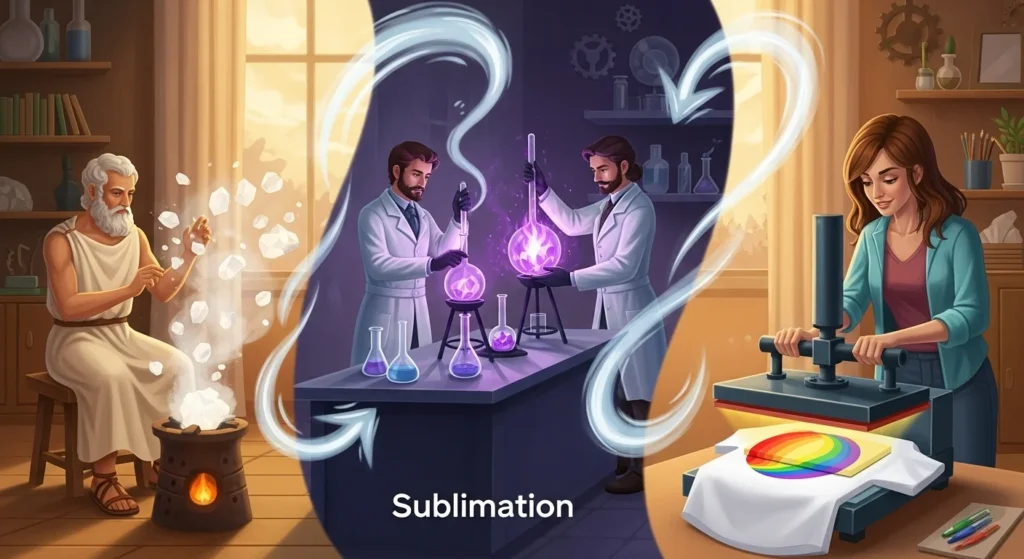Freud’s Sublimation Explained Simply: Turn Emotions Into Power
Freud’s sublimation means channeling strong or unwanted emotions into positive actions, like art, work, or creativity. It’s a healthy defense mechanism in psychology that transforms inner tension into motivation.
This process helps people express feelings safely while growing emotionally and mentally, turning pressure into productive energy.
What Is Sublimation? (Definition & Basic Concept)
Sublimation is your mind’s way of turning strong emotions or impulses into something good. Instead of acting on raw urges, you reshape them into creativity, work, or care for others.
Simple Definition of Sublimation in Psychology
In psychology, sublimation means channeling instinctive or socially unacceptable feelings into positive actions. It’s like emotional redirection. You don’t bottle up the feeling, you use it.
Examples:

- Anger becomes energy for sports or art.
- Desire becomes passion for study or design.
- Stress becomes focus on helping others.
This is considered one of the healthiest defense mechanisms because it reduces inner tension and helps people grow.
To explore how sublimation shapes behavior and emotion in real life, check out our full guide on sublimation in psychology.
Freud’s Original Framing — Instinctual Drives, Culture, Transformation
Freud saw sublimation as the bridge between our natural instincts and civilized life. Instead of suppressing drives like aggression or desire, we redirect them into socially valued goals such as art, science, or leadership.
He described it as transforming instinctual energy into cultural achievement.
It’s how the energy that could cause conflict instead fuels creation.
Key Terms You’ll Need: Id, Ego, Superego, Drives, Culture
| Term | Plain Meaning |
|---|---|
| Id | The impulsive part that seeks immediate pleasure. |
| Ego | The practical part that finds realistic ways to satisfy the id. |
| Superego | The moral part that reminds us what’s right or acceptable. |
| Drives | Basic forces like hunger, desire, or aggression. |
| Culture | The social rules and rewards that shape how we express ourselves. |
Sublimation happens when the ego takes the id’s raw drive and channels it into something the superego and culture value.
How Does Freud’s Theory of Sublimation Work?
Freud believed sublimation works by redirecting powerful inner drives into socially valued outlets. Instead of fighting or denying our instincts, we transform them into creativity, work, or purpose. It’s not suppression, it’s transformation.

The Mechanism: Redirecting Instinctual Energy into Socially Accepted Channels
Freud saw every person as full of instinctual energy, mostly from the id, which pushes us toward pleasure and immediate satisfaction. When society or morality blocks that impulse, the ego steps in to find another outlet.
That’s where sublimation happens, it’s a redirection, not a rejection.
The raw drive stays alive but finds a new, acceptable form.
Think of it like this:
- Aggression becomes sports, debate, or leadership.
- Sexual energy fuels art, performance, or passion projects.
- Curiosity leads to science, innovation, or exploration.
This mental rerouting keeps instincts active but harmless, which is why sublimation is seen as the healthiest of Freud’s defense mechanisms.
It turns potential chaos into constructive energy, emotional alchemy in action.
The “Higher Aim” Notion — Drives Moved Toward Art, Science, Culture
Freud described sublimation as the process that makes civilization possible. Instead of letting our primal urges rule us, we channel them into activities that benefit everyone, like music, research, teaching, or invention.
According to Encyclopedia Britannica, this “higher aim” gives instinct a noble direction. It’s what allows personal satisfaction and social harmony to coexist.
For example:
- An artist may pour unspoken desire into painting.
- A scientist may use curiosity born from anxiety to discover something new.
- A teacher may turn a need for control into mentoring or guidance.
Freud saw this as a win-win for the individual and society, the drive is still satisfied, just in a refined way.
Where It Sits in Freud’s Bigger Model of the Psyche (Id, Ego, Superego)
Sublimation is like teamwork between the three parts of the mind:
| Mind Part | Role in Sublimation |
|---|---|
| Id | Produces raw impulses (sex, anger, hunger, pleasure). |
| Ego | Finds realistic, socially acceptable ways to express those impulses. |
| Superego | Approves only moral or cultural expressions that align with values. |
When these three work together smoothly, instinct becomes innovation.
The id provides the fuel, the ego steers it, and the superego approves the destination, a piece of art, a project, a discovery.
If you’re curious about how creative expression can support emotional balance, read more about mental health in sublimation.
Concrete Examples of Sublimation in Everyday Life
Sublimation shows up in everyday life more often than you think. It’s what happens when strong emotions or instincts, anger, desire, frustration, fear, get redirected into creative, physical, or productive outlets that feel good and do good.
Creativity and the Arts: Turning Desire or Conflict into Art or Literature
Art is probably the most classic form of sublimation. Freud often pointed to artists and writers as examples of people who channel inner conflict into beauty or meaning. Instead of acting on desire or anger directly, they express it symbolically.
A few examples:
- A painter transforms heartbreak into a vivid landscape.
- A musician turns grief into a moving melody.
- A writer works through repressed desire or trauma in a novel.
According to research published in PubMed, creative expression often helps people release tension while building self-awareness and resilience. Freud saw this as proof that instinct doesn’t have to be silenced, it can be reshaped into something that inspires others.
In short: The arts give emotion a safe form and a lasting voice.
Physical Activity or Sports: Channeling Aggression or Drive into Action
Not everyone paints or writes, but almost everyone feels the need to release pent-up energy. Sports, exercise, or competition are perfect examples of sublimation in motion.
Think about it:
- Aggression can turn into discipline on the field.
- Frustration can become focus in the gym.
- The urge to dominate can evolve into team leadership.
As Verywell Mind notes, physical outlets like sports reduce stress and aggression by transforming adrenaline into achievement. Freud might say the athlete’s ego found a way to satisfy the id’s power drive while earning the superego’s approval.
In simple terms: You’re not suppressing your energy, you’re sculpting it.
Professional or Altruistic Outlets: Work, Service, Research as Sublimated Energy
Freud also saw sublimation in ambition, career goals, and helping others. When people channel personal desires into work or service, they’re redirecting instinctual energy into something productive and meaningful.
Real-world examples:
- A person with controlling tendencies thrives as a project manager.
- Someone driven by curiosity becomes a scientist or inventor.
- A person seeking emotional connection pours that energy into teaching, volunteering, or caregiving.
In essence: Sublimation in work or service helps you grow while giving something back.
Want practical ways to apply Freud’s idea in daily life? Try these 7 sublimation psychology hacks that turn emotion into energy.
Why Is Sublimation Considered Healthy?
Sublimation is often called the “mature” way to deal with difficult emotions. Instead of burying impulses or letting them explode, it channels that raw energy into something creative, productive, or socially valued.
Compared to Less Mature Defenses
According to Simply Psychology, Freud believed all defense mechanisms serve to protect the ego, but not all are equal in how they do it.
- Repression hides the impulse, but it doesn’t resolve it.
- Displacement redirects it, but sometimes in unhelpful ways (like yelling at someone instead of facing the real issue).
- Sublimation, on the other hand, transforms it into something positive, think of it as emotional recycling.
👉 It’s not avoidance, it’s transformation. You’re using the same energy, just in a more evolved form.
Benefits: Emotional Regulation, Expression, Growth
Modern psychology agrees this mechanism offers real-life benefits. As Calm highlights, sublimation helps:
- Regulate emotions without suppression
- Express complex feelings safely (through art, movement, or work)
- Turn inner tension into motivation
- Promote personal and creative growth
It’s like turning pressure into performance, the drive doesn’t go away, it gets redirected toward something that builds rather than breaks.
In Therapy and Personal Development
Therapists today often help clients identify when sublimation is already happening or encourage it when they’re stuck in destructive loops.
Relational Psychology Group notes that understanding sublimation can:
- Reveal unconscious motivations behind passions and career choices
- Help people process anger, guilt, or grief more constructively
- Support long-term self-awareness and emotional maturity
In other words, learning how to channel emotions creatively can be just as healing as talking about them.
Ever wonder what happens when emotions move in the opposite direction? Learn about the opposite of sublimation and how it compares.
Critiques, Limitations & Modern Perspectives
Freud’s take on sublimation was bold for its time, that our wild instincts could be refined into art, science, or culture. But like most of his theories, it’s been reinterpreted, debated, and tested in modern psychology.
Freud’s Idea and Its Evolution
The European Journal of Psychoanalysis points out that Freud’s “higher cultural aim” theory leaned heavily on early 20th-century ideals, art, intellect, and moral refinement. Critics argue that this view was a bit elitist, suggesting that only “civilized” or “intellectual” outlets counted as true sublimation.
Over time, psychoanalytic thinkers like Lacan and Jung softened this stance, recognizing everyday creativity, from cooking to sports, as valid expressions of sublimation. So the concept evolved from something reserved for geniuses and artists to something all humans do to stay balanced.
In short: sublimation got democratized.
Empirical Evidence & Research Gaps
Here’s where it gets tricky. According to faculty.fortlewis.edu, Freud’s idea of sublimation doesn’t have strong experimental proof. It’s more of a descriptive concept than something psychologists can measure directly.
Modern psychology recognizes creative coping and emotion regulation as measurable processes, which look like sublimation, but there’s no single test that proves someone is sublimating an impulse rather than just expressing it.
So while the theory makes intuitive sense, researchers still debate how to quantify it scientifically.
Example: Brain studies show overlap between emotion and creativity circuits, but that doesn’t automatically confirm Freud’s mechanism of “drive transformation.” It’s more of a working metaphor than a lab-tested fact.
Cultural & Philosophical Angles
Beyond psychology, sublimation’s been explored in philosophy, gender theory, and cultural studies. ResearchGate papers highlight a few key shifts:
- Cultural context: In non-Western traditions, transforming desire into compassion or service (like in Buddhism) closely parallels sublimation.
- Gender and identity: Some modern writers reinterpret it through a feminist lens, noting how social norms shape what’s considered an “acceptable” outlet.
- Existential take: Thinkers like Sartre and Nietzsche saw sublimation not as repression but as self-creation, a way of turning instinct into meaning.
All this shows how far the idea has traveled, from Freud’s clinic to today’s classrooms and creative studios.
For a lighter twist, discover how the same process appears in nature through our post on sublimation in nature.
How to Explain Sublimation to a Child or Layperson
Sublimation is your mind’s way of recycling feelings into fuel. It’s how we turn pain into purpose, and chaos into creativity, a quiet superpower we all have.
Simple Metaphor or Story
Imagine a steam engine. When steam builds up, it could explode if trapped. But if you use it right, that same steam can power a train.
That’s sublimation, taking emotional pressure (anger, sadness, or desire) and turning it into motion, art, or purpose instead of letting it blow up.
Everyday Language Examples
Kids and adults both do this all the time without realizing it:
- When you’re mad, you go play basketball to “let it out.”
- When you miss someone, you write a song or poem.
- When you’ve got tons of energy, you clean your room or start a project.
You’re not hiding your feelings, you’re changing their shape, like turning fire into light instead of smoke.
Why It Matters for Us All
Sublimation helps us:
- Handle emotions without hurting ourselves or others
- Stay creative, even in tough times
- Connect with people, because what we create often helps or inspires others
In short, it’s one of the healthiest ways humans deal with strong emotions, not by pushing them down, but by transforming them into something meaningful.
Creative Coping by the Numbers
Sublimation in Pop Culture and Media
Sublimation isn’t just in textbooks, you see it in movies, books, and music.
- Example 1: A character channels anger into painting or performance
- Example 2: Musicians write songs about heartbreak or frustration
- Example 3: Entrepreneurs turn personal challenges into business ideas
Quick Self-Check: How Do You Sublimate?
Interactive reflection helps readers spot sublimation in their own lives.
Checklist: When I feel strong emotions, I tend to:
- Exercise or play sports
- Create art, music, or writing
- Focus on work or learning
- Help others or volunteer
- Meditate or practice mindfulness
Tip: If you check more than one, you’re already using sublimation effectively. Simple interactive downloadable PDF checklist
Myth vs. Fact: Sublimation Misconceptions
Not everything you’ve heard about sublimation is true.
| Myth | Fact |
|---|---|
| Only artists can sublimate | Everyone can redirect emotions into productive outlets |
| Sublimation is suppression | It’s transformation, not denial |
| It happens automatically | Some people need guidance or practice to use it effectively |
The Science Behind Emotional Transformation

Sublimation works because of how our brain handles emotion and reward.
- Brain’s reward pathways release dopamine when we turn tension into action
- Physical activity or creative output lowers stress hormones like cortisol
- Over time, regular sublimation builds emotional resilience and self-control




